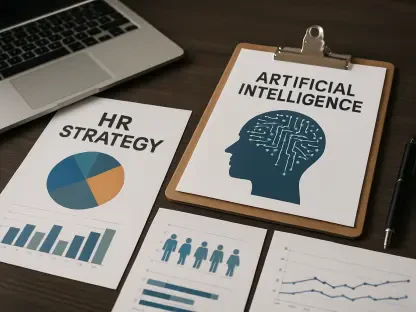In an unprecedented turn of events, the focus for HR professionals has pivoted from recruiting new talent to nurturing existing employees in 2025, as highlighted in the SHRM State of the Workplace report. This shift in priority marks a significant change in organizational strategies, where leadership and management development have taken precedence. Recruiting efforts, which once dominated the HR landscape, have now fallen behind, failing to even make the top three priorities for the year. The report underscores the importance of honing the skills and abilities of the current workforce to cater to the dynamic needs of organizations.
The Changing Landscape of Recruitment
The Impact of Decreased Job Postings
In 2025, studies, including those conducted by Indeed, have demonstrated a notable easing in the race for acquiring new talent, which was a significant pain point in 2022. Job postings saw a 10% decrease from the previous year, indicating a relaxation in the frenzied search for new hires. This decrease in postings has had a profound effect on HR strategies, steering the focus towards enhancing employee retention and career progression.
The SHRM report further accentuates this trend by highlighting an increased emphasis on developing training programs specifically designed for hourly employees. These programs aim to empower front-line workers and ensure they possess the necessary skills to excel in their roles. By investing in the development of existing employees, organizations hope to create a more stable and competent workforce, reducing the need for constant recruitment.
Addressing Recruiting Struggles with Employee Experience
The recruiting challenges faced in 2024 have also contributed to the intensified focus on improving employee experience and retention. While 56% of HR professionals regarded their recruiting efforts as effective, a mere 41% of U.S. workers shared this sentiment. This disconnect not only hindered recruitment success but also resulted in increased workloads for over a third of employees due to unfilled positions, consequently leading to widespread burnout.
The emphasis on employee experience has become imperative for organizations aiming to retain their talent. The SHRM report identifies several key areas for improvement, such as recognition programs and team collaboration initiatives. These efforts are critical in enhancing employee satisfaction and fostering an environment where individuals feel valued and supported, thereby mitigating turnover rates and alleviating burnout.
The Imperative of Talent Development
Overcoming Turnover Challenges
Despite the focus on training and developing front-line workers and hourly employees, organizations continue to grapple with high turnover rates. This persistent issue threatens to undermine talent development initiatives. However, optimism prevails, as 80% of talent development professionals express confidence in their ability to overcome turnover challenges and provide the necessary training. Nonetheless, nearly half of these professionals remain uncertain about the specific strategies required to achieve these goals.
The commitment to talent development is evident in the array of training programs being introduced across various industries. These programs are designed not only to enhance technical skills but also to foster leadership qualities among employees, preparing them for future roles within the organization. By equipping employees with the skills and knowledge needed for advancement, companies can build a robust pipeline of future leaders, reducing their dependence on external recruitment.
Enhancing Employee Experience as a Retention Strategy
The focus on improving employee experience to combat turnover remains as pertinent in 2025 as it was in 2024. Recognition and team collaboration are identified as significant opportunities to enhance employee satisfaction and drive retention. Acknowledging the contributions of employees and fostering a collaborative work environment can significantly improve job satisfaction, thereby curbing turnover rates.
Organizations are increasingly realizing the importance of creating a positive work culture where employees feel appreciated and motivated. This shift towards a more employee-centric approach is not only aimed at retaining talent but also at attracting potential candidates who seek a supportive and engaging workplace. By prioritizing employee experience, companies can build a loyal and committed workforce, ultimately leading to improved organizational performance.
Strategic Implications for HR Professionals
Advancing Organizational Resilience
The shift in HR priorities from recruitment to leadership development and employee experience enhancement underscores a strategic move towards building organizational resilience. By investing in the skills and capabilities of existing employees, companies are better equipped to navigate the challenges posed by workforce turnover and burnout. This proactive approach not only strengthens the organization’s foundation but also fosters a culture of continuous learning and improvement.
The intensified focus on leadership development is a testament to the evolving HR landscape, where the ability to adapt and thrive in a rapidly changing environment is paramount. Organizations that prioritize the growth and development of their employees are more likely to maintain a competitive edge and achieve long-term success. As HR professionals continue to navigate this shift, the emphasis on fostering a skilled and engaged workforce will remain crucial.
Future Considerations for HR Strategies
Looking ahead, HR professionals must continue to adapt their strategies to meet the evolving needs of the workforce. The emphasis on leadership development and employee experience is likely to persist, with organizations recognizing these elements as critical drivers of retention and organizational success. To remain competitive, companies must stay attuned to the changing expectations of their employees and continuously innovate their HR practices.
Developing comprehensive training programs, fostering a culture of recognition and collaboration, and addressing turnover challenges will be essential components of future HR strategies. By prioritizing the development of existing employees, organizations can build a resilient workforce capable of meeting the demands of an ever-changing business landscape.
Building the Future of Work
In an unexpected shift detailed by the SHRM State of the Workplace report, the primary focus for HR professionals in 2025 has moved from recruiting new talent to nurturing existing employees. This shift represents a major change in organizational priorities, where developing leadership and management skills has become more critical than ever. The traditional emphasis on recruiting, which previously dominated HR strategies, has declined significantly and didn’t even make the top three priorities of the year. The report highlights the essential need to enhance the skills and capabilities of the current workforce to meet the evolving demands of organizations. HR departments are now concentrating on professional development, training programs, and employee engagement to ensure the success and growth of their organizations. This change underscores a broader trend toward valuing retention and internal growth over the constant pursuit of new hires, indicating a more sustainable, long-term approach to workforce development.









